Do you all still remember the Covid epidemic?! It’s true that the past few years have been extremely difficult for everyone everywhere and that many of us have had to make substantial adjustments to our ways of working and living. People working and attending school from home have increased dramatically in recent years, and this trend appears to be here to stay. Even though Covid seems to have died down (at least for now), the movement towards online education and employment seems to be here to stay. Also, the demand for helpful resources has never been higher with this trend.
eLearning is rapidly catching up to traditional classroom instruction. WordPress is a valuable tool for making a website, and while content is king, having a suitable eLearning theme installed can elevate your online presence. It can be challenging to conduct effective online training for coworkers or students (in private courses or as part of a University/College curriculum). There are several excellent LMSs (Learning Management Systems) available that can be used to facilitate online training. Select the features and functionalities you need for your online learning course from the many plugins available for these Learning Management System (LMS) themes. The WordPress LMS ecosystem includes tools from content creation to design, placement, interactivity, and payment.
History Of Learning Management Systems
Learning management systems (LMS) have been utilized by universities since the early 1990s. But it wasn’t until the early 2000s that LMS use skyrocketed in online and distance learning. Around this time, schools began providing distance learning opportunities for graduate students. Thanks to the LMS platform, students could access their courses, interact with their teachers and peers, work on group projects, and turn in their work for evaluation from any location with an internet connection.
Initially, the primary focus of most LMS platforms was on facilitating in-class instruction, with online features being an afterthought. However, as LMS adoption grew, so did the features available on these platforms, making them more conducive to online and distance education. Nowadays, many schools provide Master’s degrees that can be completed online and delivered solely through LMS platforms.
In recent years, there has been a shift towards employing LMS platforms that reside in the cloud rather than onsite servers. This gives students more freedom regarding when and where to access course materials and makes it easier for universities to expand their online programs.
Even though LMS platforms have been around for only a short period, this period has been one of tremendous development and innovation. Online education is becoming increasingly popular amongst students worldwide as LMS platforms become more advanced and user-friendly as technology develops.
Factors To Consider Before Choosing A LMS
1. Focus on the user experience
Please understand us; we still think features are essential. It doesn’t mean they’re irrelevant, though. Rather, it’s about striking a balance between the functionality you require and the user experience you desire. While it’s easy to overlook, the user experience may significantly influence the quality of your training. Consider the issue of student participation and acceptance. One of the most challenging aspects of implementing a learning management system is getting people to actually utilize it. Is it the proper LMS if it’s jam-packed with capabilities, yet the learner dashboard is confusing and slows down the learning process? In all likelihood, no.
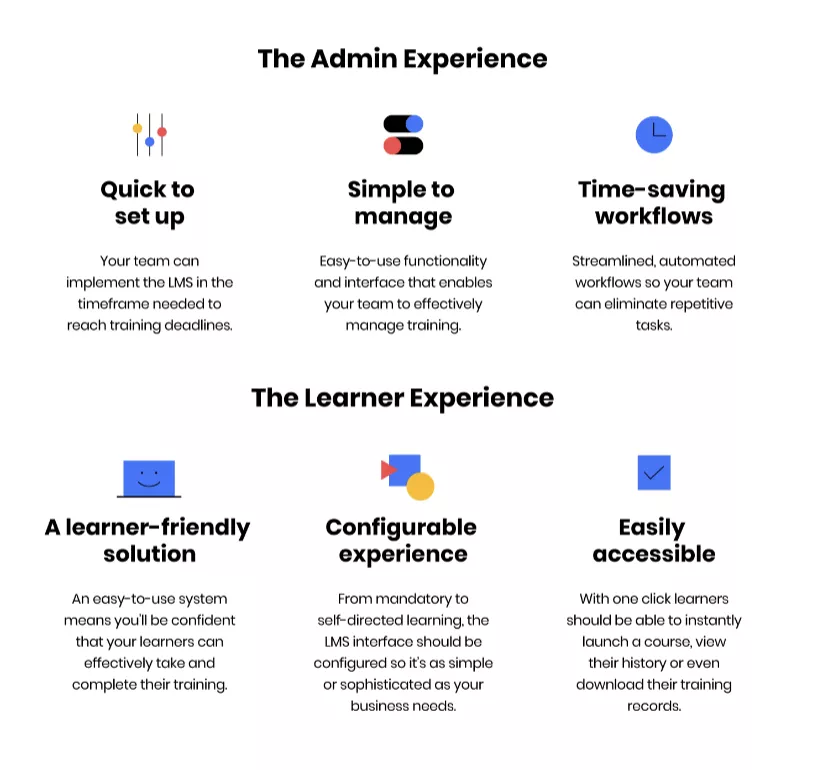
Instead, a fantastic learning management system interface should accomplish one thing: facilitate the realization of your educational objectives.
2. Choose features wisely
What It’s Like to Be a User- with this in mind, it’s time to zero down on the specific capabilities your team requires to provide training. Most importantly, all of your training’s aspects tie back to that ultimate aim.
Once you know this, you can zero in on the specific strategies that will bring you closer to your objective. Doing so can ensure that your learning management system (LMS) is the correct size for your organization’s needs instead of being overburdened with capabilities you’ll never use. This will save you from throwing away money or badly hurting the customer experience.
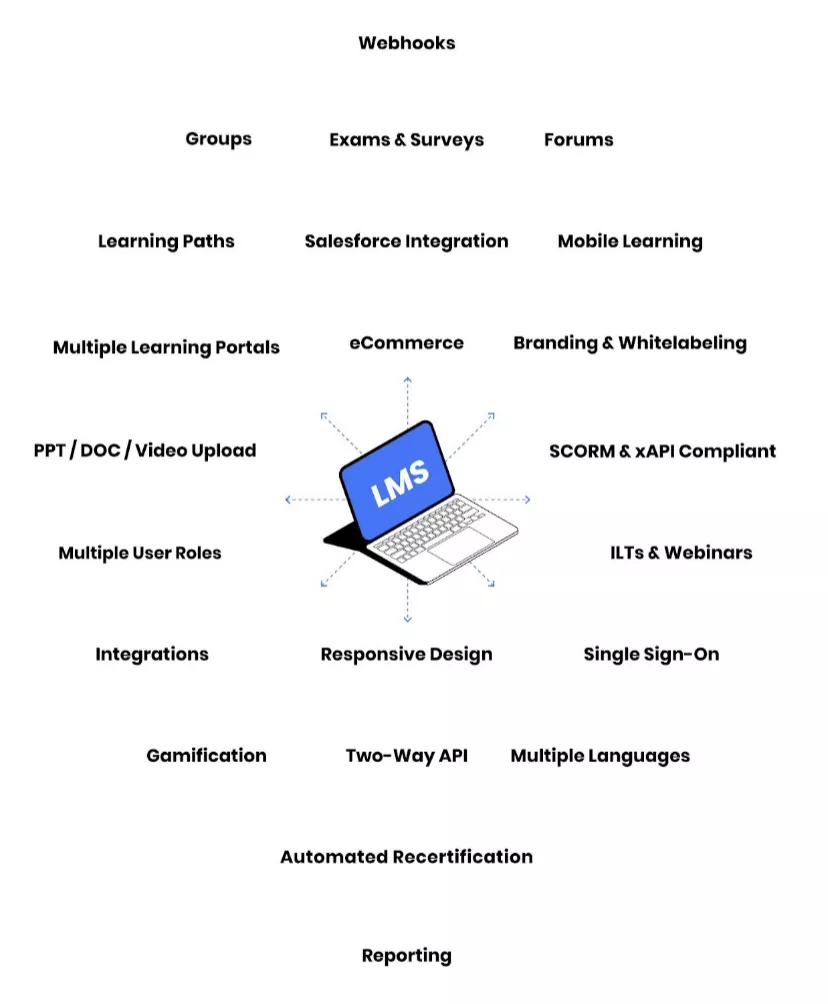
This is simpler to say than to do. With experience with an LMS, your company may know what essential functions are. One way to accomplish your objective is to reverse engineer the process. Aligning your organization’s needs with the capabilities of a learning management system entails examining the obstacles standing in the way of its progress toward a certain objective and considering the role that an LMS may play in overcoming those obstacles.
By outlining the steps involved, you’ll be able to cherry-pick the features you need while bypassing the extraneous ones that will serve to clog up your LMS. Most significantly, it will help you narrow down your search for an LMS.
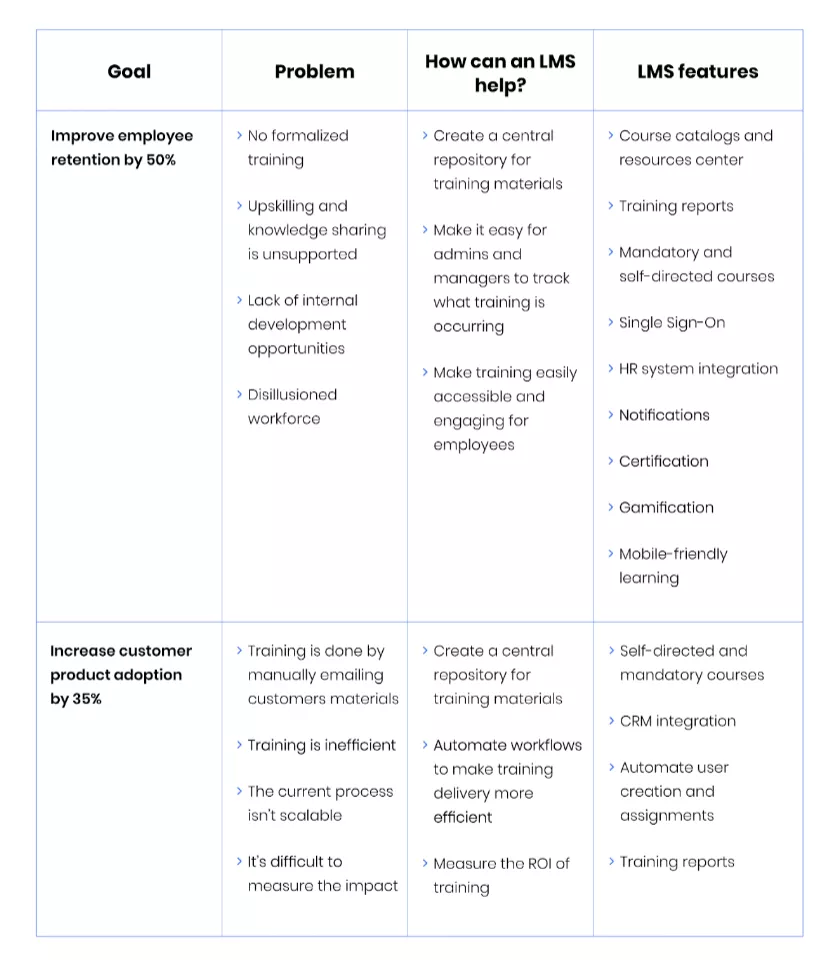
3. Make integration a top priority
There is no such thing as a standalone piece of software, and in its place is an ecosystem in which all software solutions work together to streamline processes and automate routine chores.The same logic applies to an LMS.
Nevertheless, integrations are a source of frustration for many organizations.
According to research conducted by Brandon Hall, 87% of big enterprises and 75% of small to medium-sized organizations rate it as the top enhancement wanted in their next LMS.
How can you check if the LMS you’re considering purchasing contains the necessary add-ons?
Like before, you should have all your ducks in a row and have decided which tools you want to link to the LMS before you even begin your search. All personnel records must be entered into the LMS so that workers can access their training anytime. Using an LMS that can communicate with your HR software is rational, and this will ensure that new hires are immediately added to the LMS after being introduced to the HR system.
Furthermore, staff members should have quick and easy access to relevant training materials.
With SSO in place, they may skip the sign-in process altogether and go straight into the learning management system (LMS). The training process will be simplified since they need just access to the dashboard to be presented with relevant course material.
This is only the beginning. Connecting your LMS to your CRM allows you to quickly and easily add hundreds or thousands of clients for the express purpose of training and educating.
And if you’d rather conduct training sessions in real-time, all you have to do is connect with a webinar platform of your choice. Many further options exist.
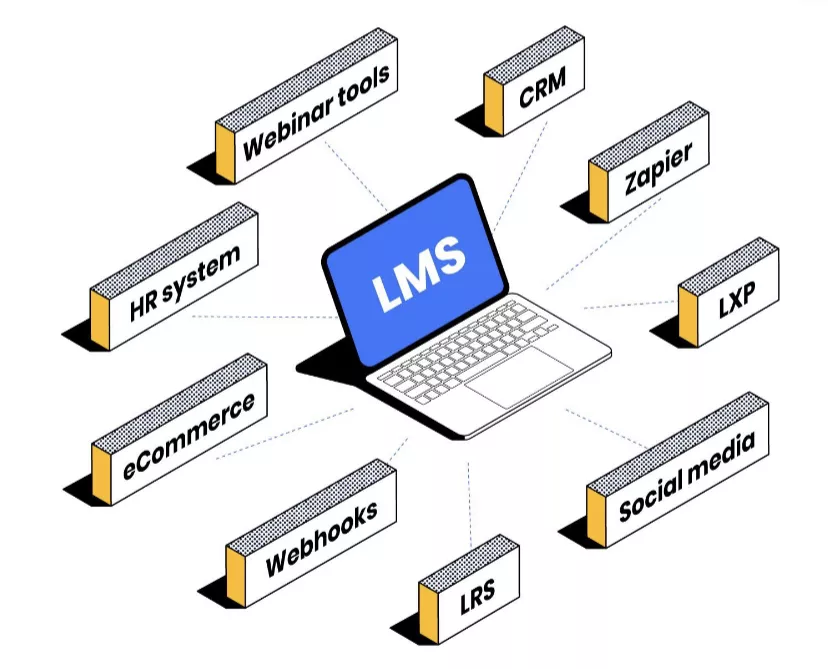
4. Quality of customer support
Anybody who has ever used a learning management system knows the importance of having access to helpful representatives.
Today’s businesses are looking for something other than another piece of software; they want a reliable collaborator in their quest for growth. Similarly, according to Brandon Hall’s survey, 69% of businesses want a partner, and 66% want improved technical assistance from solution providers.
What, though, does good service to customers actually look like? They see themselves as your strategic Onboarding Expert, committed Customer Success Manager, and skilled Technical Customer Support Representatives, all of whom are by your side during your whole corporate learning journey. From the beginning of the onboarding process to its completion and beyond, they will be there to assist you as a partner.
Use simple inquiries to gauge a vendor’s level of service while dealing with customers. To help narrow down your options, we recommend asking each provider about their support availability, preferred methods of contact, average response time, and other such fundamentals. This may gauge how much effort the provider has put into their product.
You may also ask each vendor what their customer NPS score is (if it’s excellent, they’ll tell you! ), which is a measurement of customer happiness and read about the experiences of existing customers in online reviews.
Some questions to consider while evaluating a vendor’s customer service are as follows:
- Will our company have a Customer Success Manager?
- Where can I find the customer service hours?
- Where do we stand on paid time off for federal holidays?
- How can I get in touch with customer service? Can I send an email, call, or do both?
- Does their response time tend to be quick?
- Is there any information on how well they care for their customers online?
- Approach to pricing
In the LMS market, no standard pricing structure applies across the board. However, this complicates matters when attempting to compare prices from different suppliers.
Costs are often calculated according to the number of users that are actively logged in.
If you are still determining your company’s requirements, you should first consider the use case your company now has, and only then should you consider future usage.
To illustrate this point, let’s say you have a staff of 1,000 people and are required by law to provide them with compliance training. In this case, you may safely assume that at least 1,000 people will use the training. Consider your client growth rate over the previous several years if you’re implementing onboarding training for new customers.
If you have a firm grasp on the pricing, inquire about any additional fees. No one likes being blindsided by unexpected costs. For instance, if you want a price plan that adjusts to your consumption, know what happens if you exceed your allotted number of users. While planning your LMS budget, it’s essential to remember that most systems are transparent about all the fees involved.
While comparing vendors’ costs, you should also think about the following:
- Is there a restriction on the amount of content or number of courses I may upload?
- Can there be several administrators?
- What kind of contract terms are on offer?
- If I need to cancel my reservation, what is the procedure?
6. Implementation timeframe
The time it takes to implement an LMS varies widely, depending on factors such as the complexity of the integration and the vendor’s efficiency. A range of several hours to many years is possible here.
A company’s internal processes are also key to ensuring a smooth and rapid launch. Inquiring about time commitments is a sensible move when evaluating LMS providers. A clearer picture of their ability to assist you in meeting crucial learning deadlines will emerge.
Although many of these will only be relevant if you’re purchasing a prepackaged cloud service, it’s still a good idea to inquire about expected delivery dates for requirements workshops, data migration, administrator training, etc.
Find out how long other firms with comparable requirements take to get up and operate. This provides a more precise estimate of when to start making preparations.
7. Scalability, reliability, security
Key features are scalability, dependability, and safety.
All of these may affect the success of your programs, the standing of your company, and the usefulness of the LMS in the future.
By probing them about their approach to these areas, you may determine whether or not it is safe to entrust your selected vendors with your company’s data. Also, ask yourself if the company’s LMS can expand your business.
For more information on these topics, consider the following questions to ask the suppliers you have narrowed your search down to:
- Can we get more people to use it?
- Is there a content or course upload limit?
- Please tell me the typical downtime.
- Have you set up regular monitoring of the system?
- Does your organization have a strategy for returning quickly after a catastrophic event?
- Is there any known history of data breaches?
8. Product roadmap
Finding a solution that meets everyone’s needs right from the off is quite rare. The landscape of education, however, is always changing.
As important as it is to learn about the features that a vendor’s LMS now offers, it is equally important to learn about the features they plan to add.
You may gauge the vendor’s commitment to developing and refining their product further by looking at their roadmap, provided they keep it up to date. The company’s roadmap should show that its LMS has been updated with the latest industry standards and will remain an appropriate choice for your expanding firm.
Top LMS of 2023
1. LearnDash

Learndash, an e-learning platform that has been in development for over a decade, has dramatically impacted the work of educators and curriculum developers.
The firm was conceived in 2012 by Justin Ferriman, a passionate educator who saw the potential for online education to transform the educational landscape.
The platform’s intuitive design makes it easy for educators to create and administer courses. Learndash has evolved, gaining additional features to serve its user base better.
Learndash’s pivotal moment came in 2013 when it published a plugin for the WordPress platform. This made it simple for educators to integrate Learndash into their own WordPress sites, thus increasing the platform’s potential user base.
It is used by many businesses, from Fortune 500 corporations to universities and startups. It’s a great pick for educators who want to promote and manage access to their online classes. It can be easily managed thanks to the integrated tools.
Moreover, the newest LearnDash edition includes a feature called Focus Mode. This is a first for LMSs and provides a tranquil environment for students to learn. It can be used for individual pages or classes to eliminate extraneous content like sidebars. The progress bar will always be displayed, even if the navigation bar is hidden.
Pros:
- You can make and sell as many courses and tests as you like with little effort.
- Timed drip-feeding of information, etc.
- Recognize users with badges and points.
- Easy-to-use drop-and-drag interface with numerous customization options
- Options for one-time purchases, memberships, subscriptions, and online shopping carts all exist.
- Ability to set up automatic payments through services like PayPal and other payment processors
- Library of both official and unofficial add-ons that are compatible with other plugins
- Managing users is simple, and everyone can see where they stand.
- Obtain complete data sets
- Allows for use with mobile devices
Cons:
- Many features are available in the core plugin, which are unclear.
- The premium features, like advanced reporting, are unavailable on the starter plan.
Pricing:
Pricing for learning dash’s Basic plan, which supports a single site, is $159 annually. You’ll need to upgrade to one of our more expensive plans to access the ProPanel reporting dashboard. Prices range from $189 for the Plus plan to $329 for the Pro plan, with the Plus plan covering up to 10 sites and the Pro plan covering up to 25 sites. There’s a 30-day refund policy, too.
2. LifterLMS
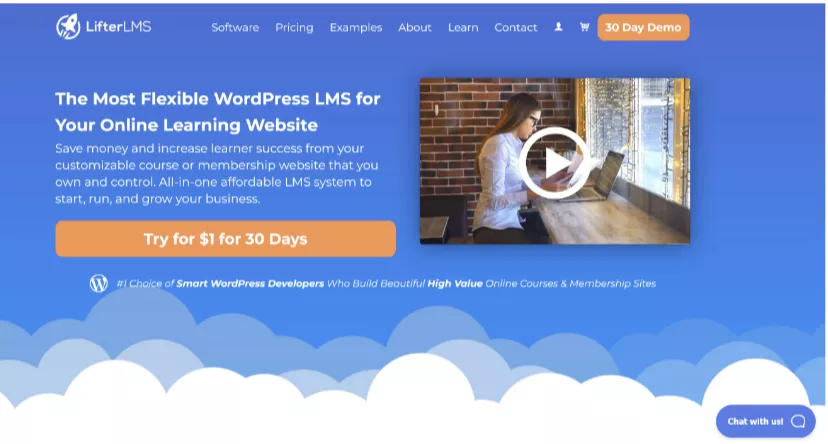
Experts, Coaches, and Business Owners can build a beautiful online course website with the help of LifterLMS, a robust WordPress Learning Management System. The plugin allows for interactive quizzes, course creation, and multimedia instruction. In addition, you can import and export courses, conduct course reviews, integrate forms and download lessons.
Credit card payments, recurring payments, payment plans, unlimited pricing models, PayPal integration, and much more are all supported by the plugin, allowing you to monetize your online course website easily.
When combined with the BuddyBoss Theme, the LifterLMS plugin allows you to build a fully functional platform for offering online courses. LifterLMS is fully compatible with the BuddyBoss Theme and the BuddyBoss Platform, thanks to the extensive effort put in by the BuddyBoss team. Purchasing LifterLMS grants you full WooCommerce compatibility. In addition, it offers a drag-and-drop interface for creating courses, making it popular among educators.
Pros:
- The core plugin is open source and available at no cost.
- Combination of Beaver Builder and Divi
- Equipped to work with various online payment systems
- Offers comprehensive content administration features
- Implementing a gaming element by awarding completion certificates and badges
- Simple to scale up or down
- built-in support for conversion-boosting marketing tools like MailChimp and WPForms
Cons:
- You will need to spend money on a payment gateway, which is a drawback.
- Some of the most expensive add-ons and clumsy interfaces make it challenging for newcomers to pick up.
- The functionality of large websites may be compromised.
Pricing:
This core plugin is available at no cost. There are separate add-ons available for purchase if you need more functionality. Unfortunately, their high price makes the package a more sensible choice.
LifterLMS’s extensions are included in the $99 per site, per year cheapest package. After that, you can upgrade to the Universe bundle for $299 per year for five areas or the Infinity bundle for $999 per year for an unlimited number of sites. There are additional capabilities included with each of those options. It only costs one dollar to try the service for a whole month.
3. Sensei

Sensei is a WordPress LMS plugin with simple drag-and-drop eLearning courses and platform-building tools for everyone. To create interactive lessons and tests, Sensei is accessible to anyone.
Since Sensei LMS originates from the same company that brought you WordPress, WooCommerce, and Jetpack, you can rest assured that it will do an excellent job for your site. As a bonus, this ensures you can use Automattic tools to boost your site’s efficiency.
In addition, the LMS plugin is simple to install in WordPress, and you can use the WooCommerce plugin to market and sell your training programs. In addition, you can administer tests, quizzes, and homework assignments at any time and view your students’ results in real-time.
As with other WordPress LMS plugins, Sensei LMS has helped educators and learners circumvent COVID-19’s geographical limitations and build a personalized learning community regardless of physical location.
Pros:
- Incredibly simple to use, even for a newcomer.
- WordPress-friendly seamless integration
- All WooCommerce templates are fully supported.
- provides basic analytics for courses, including data on enrolled students, course completion, and more
- Offers a wide variety of customizable templates
- It allows extensive mechanization
Cons:
- Some users have reported problems when attempting to integrate their WordPress theme.
- Costs can quickly add up because of the necessity of paid add-ons and upgrades to the base free version’s functionality.
- It must be coupled with membership or e-commerce plugins to facilitate access to sales.
Pricing:
This plugin has no cost associated with it. But supplementary items are required for full functionality. In addition, some of them are costless to use. The prices of the others start at $29 and go up to $249.
4. LearnPress
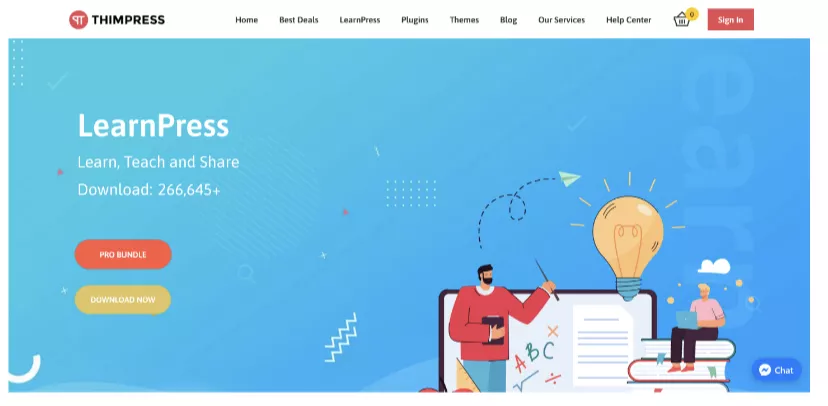
Educationists, businesses, and websites benefit from the LearnPress plugin for developing and marketing online courses. With it, you can set up a learning management system (LMS) and provide your students with a curriculum complete with lessons and quizzes. Do you need to know how to code to utilize LearnPress? A resounding “no” is the correct response, as its strength lies in its accessibility to users of all skillsets and backgrounds. No coding requirements exist, so even non-technical people can create their courses.
The freemium model is another reason it is the plugin of choice for many online instructors. You can start using the game-changing LMS plugin immediately and earn money online because it is available at no cost. Additionally, with support for 14 languages, LearnPress is a godsend for tutors who don’t speak English as their first language.
Indeed, it is not surprising. In terms of popularity, LearnPress has over a hundred thousand users and is widely considered the top learning management system (LMS) available for WordPress.
Pros:
- Integrates with all WordPress themes.
- Multiple site support
- Allows you to oversee your entire class in one place (sharing it, management, statistical analysis, and more)
- Assistance for numerous built-in payment methods like PayPal and Stripe
- Scope of improving your interactions with students (BuddyPress support)
- Adds fun and excitement to education through game-based techniques (points system and badges system)
- No annual charges
Cons:
- Providing superior customer service is an area for improvement.
- Can become unresponsive under heavy load.
Pricing:
LearnPress has a free version but offers three premium pricing plans, ranging from $49 to $249.
5. WP Courseware
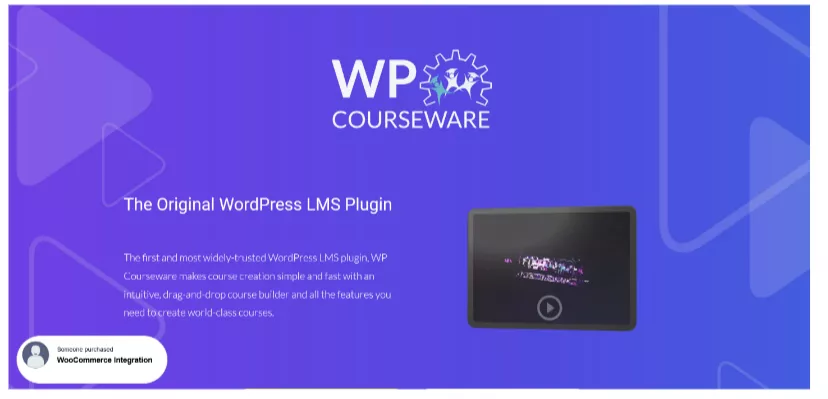
Using the power of the cloud and the WordPress platform, WP Courseware equips businesses with the means to design and implement individualized training programs and enhance existing learning management methods. Supervisors can manage and develop course modules using a drag-and-drop interface, with the content added as needed.
Customers can purchase multiple courses at once and streamline their enrollment procedures with the help of WP Courseware’s built-in shopping cart functionality. Managers can assign users to specific groups, give roles to teachers, and set up release windows for content. Also, students can upload their work, and teachers can share their lesson plans in PDF format.
Pros:
- It provides a visual editor that lets you arrange elements with ease
- Generates both blocking and non-blocking quizzes for students to take.
- There’s a pre-existing function for adding new users called Instructor that lets you monitor each student’s development and output in real-time.
- Completely compatible with all major payment processors, including PayPal and Stripe
- It protects your work and keeps your courses from being copied.
- Facilitates better management of your students by letting you view their grade books
Cons:
- Courses cannot be sold without integrating with an online store.
- Membership plugins are necessary to secure the content in some instances.
Pricing:
Prices range from $99 to $199 per year. You also get a bonus of a 2-site license for the package at $99. You can try WP Courseware risk-free for 30 days, too.
6. MemberPress
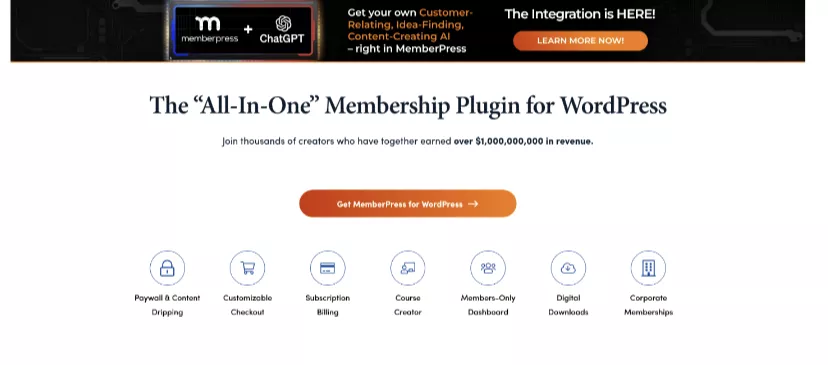
MemberPress Courses stands out because it is an extension of the viral MemberPress plugin. For creators, this ‘All-in-One Membership & Monetization WordPress Plugin’ has resulted in over $1 billion in sales.
MemberPress has been a popular plugin for WordPress sites since 2013. It’s been around for a while, it’s constantly being improved upon, and it’s widely regarded as one of the best membership plugins.
Building a membership site is MemberPress’s primary function. With this plugin, you can restrict access to certain content and decide who sees what when they log in as a member. It also (crucially) lets you charge users to access this information (i.e., becoming site members). That being said, MemberPress makes it simple for you to start making money off of your valuable content right away. No longer will you need to deal with the hassle of integrating multiple payment gateways or creating complicated custom post types to manage user access. Instead, you can focus on making money-making content thanks to the MemberPress plugin, which handles the tedious backend work.
There isn’t a more intuitive WordPress LMS plugin than MemberPress. It has many potential educational and pedagogical applications, including the development of online learning materials, the security of content, and the provision of a medium for user participation. When combined with powerful add-ons like LearnDash, you have a complete, encompassing answer for membership and digital education.
Pros:
- Supports unlimited content and subscriptions.
- A built-in drip mechanism controls and locks down the content.
- Enables the insertion of autoresponder emails and has integrated transaction management
- Has an affiliate program, is compatible with several payment processors
- Provides its clients with first-rate support and allows users to exchange files and access latest information instantly.
Cons:
- WooCommerce compatibility is not included.
- Only a few users are actively installing packages.
- Fake countdown clocks with “Limited time offer.”
Pricing:
Annual costs for up to five sites range from $149 for one site to $349. An affiliate program is also included in the top package. Also, you can test it out with the 14-day money-back guarantee.
7. MasterStudy LMS
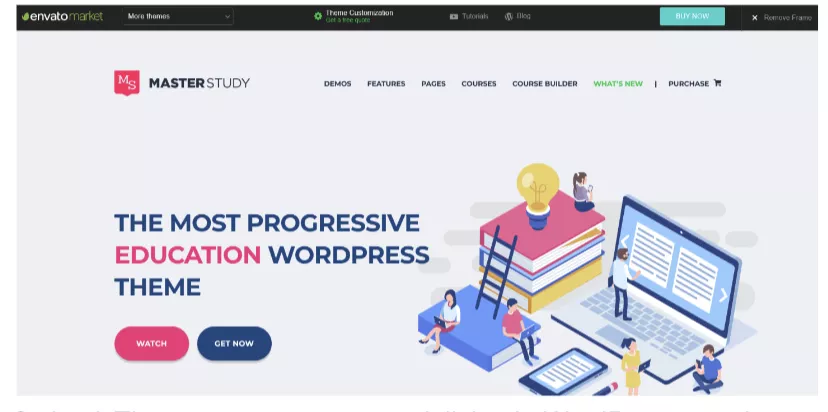
StylemixThemes, a company specializing in WordPress templates and add-ons, released its learning management system in 2016. Since its release, Masterstudy has attracted tens of thousands of users worldwide, making it one of the most widely used WordPress LMS plugins.
For those who believe open-source software lacks the functionality and user-friendliness of proprietary alternatives, consider the following: Over 43 percent of the web runs on WordPress. Why? Simply because it is practical, friendly, and costs less to use.
Masterstudy also supports numerous payment gateways, making it simple to monetize courses and accept payments from students worldwide. The platform’s compatibility with widely used apps like WooCommerce, MailChimp, and PayPal makes it simple to automate routine tasks in online education and training.
In conclusion, Masterstudy is a robust and adaptable LMS platform that can aid businesses of any size to implement highly efficient and exciting training and education initiatives. Create and deliver courses tailored to your organization’s needs and goals with Masterstudy, whether you’re a small business, non-profit, or a multinational corporation.
Pros:
- Friendly, intuitive, and interactive user interface
- Simple integration with popular payment processors like PayPal and Stripe
- facilitates regular payment installments
- Includes a star rating system for evaluating classes immediately
- Course Completion Certificates
- Connects students directly with instructors for instantaneous help with course-related issues
- Includes the ability to create multiple quizzes and timers.
- Continuous availability of a support staff
- Features a questions section with extensive frequently asked questions
- Features an affiliate program
- Online courses with video, text, and PowerPoint presentations
Cons:
- Gamification tools could use some fine-tuning
Pricing:
The core plugin is free for download. However, the ‘Premium’ plugin has three packages to choose from. It costs $39 for a single site, $69 for five sites, and $129 for 25 spots. All packages get one year of support and updates. It also comes with a 30-day money-back guarantee.
Conclusion
The educational system has followed the rest of the world into the digital age. Due to the meteoric rise of distance learning, LMSs are now more critical than ever. Using an LMS is like waving a magic wand; learning becomes simple, convenient, and enjoyable. This blog post will discuss the numerous advantages of utilizing a learning management system (LMS) for distance learning.
WordPress LMS platforms are becoming increasingly popular for students and instructors to take lessons online and generate revenue. A lot of coding is involved in creating a Learning Management System, but the revolutionary LMS plugins streamline the process. WP Courseware stands out among these LMS plugins as a go-to choice for beginners due to its ease of use in creating user-friendly educational websites.



